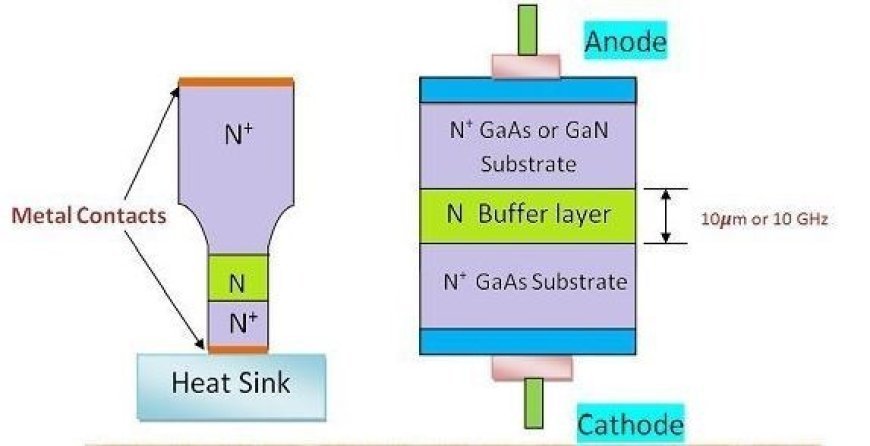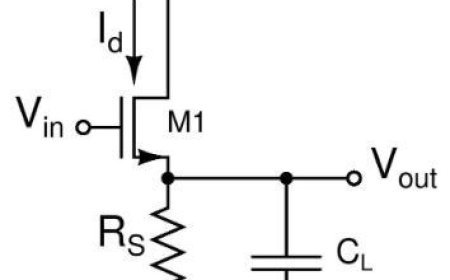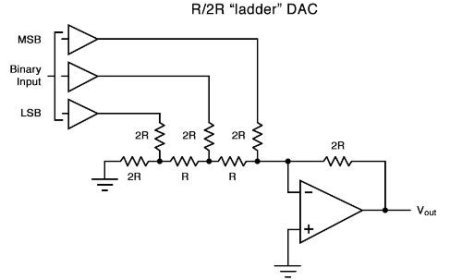GUNN DIODE
Gunn diode: A negative resistance diode generating microwaves with the Gunn effect.

- A semiconductor device is a Gunn diode. This gadget is also known as a TED (transferred electron device).
- A gunn diode is a semiconductor component having two terminals and a negative resistance.
- It is based on the "Gunn effect," which was created in 1962 by physicist scientist J. B. Gunn.
- It is primarily used in electronics oscillators to create microwave frequency, which is then used in applications such as radar speed guns, microwave relay data link transmitters, and automated door openers.
THE GUNN DIODE
- Gunn diode is a two-terminal semiconductor diode that is made up of just n-doped semiconductor material, as opposed to other diodes that have a p-n junction.
- A Gunn diode operates on the Gunn Effect. Gallium Arsenide (GaAs), Zinc Selenide (ZnSe), Gallium Nitride (GaN), Cadmium Sulfide (CdS), Cadmium Telluride (CdTe), Indium Antimonide (InSb), Indium Arsenide (InAs), and Indium Phosphide (InP) are examples of materials that can be used.
CONSTRUCTION OF A GUNN DIODE
- The Gunn diode is built from semiconductors of the N type. Gallium Arsenide (GaAs) and Indium Phosphide (InP) are two materials that are often used.
- It employs N-type material because the effect of transferred electrons is simply suitable to electrons rather than holes as observed in p-type materials. This component is divided into three sections: top, middle, and bottom.
- The Gunn diode technique begins with an epitaxial layer of on a degenerate n+ substrate to build three n-type semiconductor layers, with the n+ layer being significantly doped in comparison to the middle n layer.
- The active layer has a diameter of a few microns to 100 microns, while the doppled layer has a dimension of 1014cm-3 to 1016cm-3.
- The dimension of the layer may be changed depending on the frequency necessary. It is also coupled with a metal contact at either end of the Gunn diode to assist biasing.
SYMBOL OF THE GUNN DIODE
The Gunn diode symbol is two triangles with one vertex in point contact. The Gunn diode symbol is displayed below.
THE GUNN EFFECT
- In a semiconductor material such as GaAs, electrons exist in two states: low mass high velocity and high mass low velocity.
- When an electric field is provided, electrons from the low mass, high velocity state move towards the high mass state.
- At a specific point, electrons flow at a constant rate. As a result, current flows in the shape of a sequence of pulses. This is known as a "Gunn Effect," and it is used in Gunn diodes.
- Alternatively, "the Gunn effect is the creation of microwave power (GHz) anytime the voltage supplied to a semiconductor device exceeds the critical voltage or threshold voltage value."
GUNN DIODE’S WORKING
- The diode is built entirely of N-type materials like gallium arsenide and indium phosphide.
- This material has one more energy band gap than regular semiconductor materials, which have just two energy bands, the valence band and the conduction band. The third energy band is initially vacant.
- When a voltage is put across it, the applied voltage is visible on the active area. The electron moves from the conduction band to the third band. GaAs mobility in the third band is lower than in the conduction band.
- We boost the forward voltage even more, and this voltage increases the field strength.
- The number of electrons reaching the condition where their effective mass increases decreases as their velocity decreases, and therefore the current decreases.
- The drift velocity decreases as the field strength increases. This creates negative resistance in the V-I connection. The rise in voltage causes an increase in negative resistance.
GUNN DIODE’S CHARACTERISTICS
The VI properties of a Gunn diode are depicted in the image below.
- The Gunn diode has comparable properties to the tunnel diode.
- According to the graph, the current in this diode begins to increase immediately.
- However, after a specific voltage level or threshold voltage is reached, the current begins to decrease before increasing again.
- The zone where current begins to decrease and voltage begins to increase is known as the negative resistance region, and it oscillates as a result.
- In the negative resistance zone, the diode functions as an amplifier as well as an oscillator.
Modes of Operation of Gunn Diode
The Gunn diode functions in four modes, which are listed below:
1. Mode of Gunn Oscillation.
2. Mode of Stable Amplification.
3. Charge accumulation mode with limited space.
4. Oscillation Mode of the Bias Circuit.
Gunn Oscillation mode
This mode is characterized as being in the area where the product of frequency multiplied by length is around 107 cm/s and the product of doping multiplied by length is larger than 107/cm2.
Stable amplification mode
This mode exists in the area where the product of frequency multiplied by length is around 107 cm/s and the product of doping multiplied by length is 1011 to 1012 /cm2.
LSA oscillation mode
This mode is characterized as being in the range where the product of frequency multiplied by length is around 107 cm/s and the quotient of doping divided frequency is between 2104 and 2105/cm.
Bias circuit oscillation mode
This mode occurs only when there is Gunn or LSA oscillation, and it frequently occurs in the area where the product of frequency times length is too tiny to show in the figure.
What's Your Reaction?



































